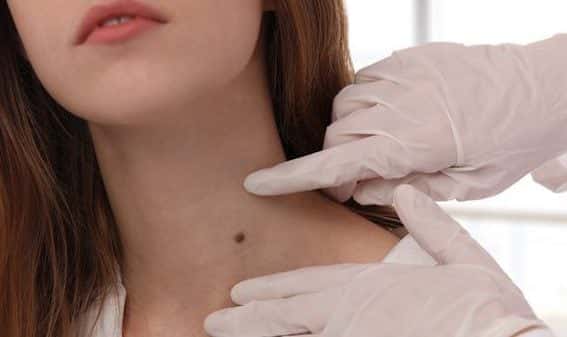
Skin cancer is the most common type of cancer in the U.S., and the earlier it’s detected in a suspicious mole or other spot, the more easily it can be treated.
What is skin cancer?
Skin cancer is the abnormal growth of skin cells. It’s most often caused by UV (ultraviolet) radiation that comes from sunshine or tanning beds, which triggers cell mutations or genetic defects.
What are the signs and symptoms of skin cancer?
The following characteristics of moles or other spots are some of the most common signs and symptoms of skin cancer:
- New spot on your skin
- Sore that doesn’t heal
- Looks different from others on your body
- Asymmetry – one half doesn’t look like the other half
- Border – irregular or blurred borders
- Color – variations in color
- Diameter – larger than a pencil eraser
- Evolving – changes in size, shape, or color
- Pigment from the border spreads into the surrounding skin
- Redness beyond the border
- Change in sensation such as itchiness, tenderness, or pain
- Scaliness, oozing, or bleeding
How can I determine if my mole is cancerous?
If you have any signs and symptoms associated with skin cancer, make a doctor’s appointment. If necessary, your doctor may examine your spot with a dermoscope. This handheld magnifying device shows internal skin structures and colors.
A biopsy may also sometimes be performed. In this simple procedure, your doctor will remove all or part of your spot and send the cells to a lab to determine whether cancer is present.
What is the process of a skin cancer screening?
During a skin cancer screening, your doctor will perform a head-to-toe examination, making note of any spots that need a closer look or should be monitored over time. Areas covered include your scalp, face, mouth, hands, feet, trunk, extremities, eyelids, ears, fingers, toes, and toenails.
In between screenings by your doctor, you can examine yourself using a full-length mirror if possible. Start at your head and work your way down, checking all the areas you can. A handheld mirror or a family member can help you get a closer look at areas such as your scalp.
If you see any suspicious areas, take a picture if possible so you can monitor any changes that may occur.
How is skin cancer treated?
Skin cancer treatment depends on the type of skin cancer, how large it is, and how far it has spread.
Small localized basal cell and squamous cell carcinomas may be removed surgically or with a scraping tool and then cauterized, frozen with liquid nitrogen, or killed with radiation. An ointment that contains an immune response modifier or a chemotherapeutic agent can sometimes be used to treat a superficial tumor. Larger, localized tumors are surgically removed.
Melanoma tumors must be fully removed, along with some surrounding tissue. Although radiation and chemotherapy won’t cure advanced melanoma, but it can be used in some cases to slow the disease and relieve symptoms.
Immunotherapy is a newer form of treatment that’s used to stimulate the body’s immune system in order to attack and kill cancer cells.
If you need a routine skin cancer screening or have concerns about a specific mole or other spot, make an appointment today with Greater Miami Skin & Laser Center in Miami Beach. Our dermatologists specialize in the most current technology available for a variety of cosmetic and medical dermatological needs, including skin cancer detection and treatment.

